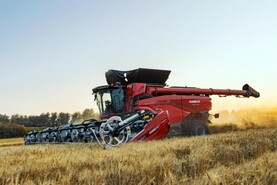Winter barley disappointed
Winter barley harvesting is largely complete, but growers in the northwest have been badly hit by recent heavy rain which may have caused damage.
With the bulk of winter barley now harvested, it is obvious that the harvest to date has been variable and disapointing. It has been very variable within farms and across farms and regions.
There are too many disappointing yields to hit a good average, even though some growers had farm average yields above 4t/ac.
Indeed, if there are any records in 2022 they are at the lower end of yields for the crop, with so many reports of fields doing under 2.5t/ac and up to a tonne under that.
Many factors may have had an influence and they all point to the fact that winter barley is still not a very robust or resilient crop.
Harvest moves on
The harvest has moved on to winter rape and oats, with some spring barley coming under the knife since last weekend and there has also been winter wheat harevsted.
However, the forecast indicates that harvest conditions may be less favourable in the week ahead. Indeed, ground conditions are now a concern as one moves north and west.
Maturity has been accelerated in all early sown spring crops in recent weeks following the recent high temperatures. The first crops of spring barley have all been quite promising, with yield reports ranging from 2.8 to 4.0t/ac.
Straw chopping
Where straw is being chopped, either as part of the straw incorporation measure or because of lack of demand, it is important to get some mixing of straw and soil as quickly as possible post-harvest. The objective is to get soil biology working and weeds growing.
Three-crop rule
While it may not matter to most growers, the commission has proposed a derogation on both the rotation requirement and the need for at least 7% idle land as part of CAP in 2023.
This gives some flexibility on crop choice and land use, but rotation is for the long haul and should not be readily abandoned. Grain is not valuable enough to displace the benefits of rotation.
Burning off
We must remember that glyphosate can only be used pre-harvest on crops where a weed control measure is required and not just for burning off. Glyphosate is not allowed for use on crops for seed, malting or milling.
Grass weeds
If there are patches of grass weed remaining in crops, two specific measure are highly advisable:
1) Note exactly where these patches occur prior to harvest.
2) Gather mature plants of each grass for identification.
These actions help to target these specific weed problems in future crops. They also help crop inspection accuracy.
If any of these weeds were sprayed and survived, contact Teagasc to have the specific grass weed tested for resistance.






 This is a subscriber-only article
This is a subscriber-only article










SHARING OPTIONS: